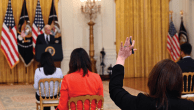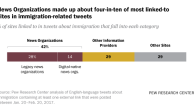Summary of Findings

The public expresses far more trust in the news media for information about the Gulf oil leak than it does in either the federal government or BP.
Fully 67% say they have a lot (20%) or some trust (47%) in information on the oil leak coming from news organizations. That compares with 51% who have at least some trust in information from the federal government and 39% in information from BP.
The latest News Interest Index survey, conducted June 3-6 among 1,002 adults by the Pew Research Center for the People & the Press, finds that the oil leak continues to dominate the public’s news interest. Nearly two-thirds (66%) cite the Gulf disaster as the story they followed most closely – more than seven times the percentage citing the economy (9%), the second-leading story. As the disaster continued to grow, the leak was also the most heavily covered story, accounting for 35% of the newshole last week, according to the Pew Research Center’s Project for Excellence in Journalism.

The survey finds that the public is much more interested in the impact of the Gulf oil leak and how far it might spread than in the response by politicians or assessments of blame.
Nearly three-quarters (74%) say they are very interested in the impact of the leak on the environment and wildlife in the gulf; 71% say they are very interested in projections of how far the oil will spread. Smaller numbers say they are very interested in how elected officials in Washington are responding to the leak (54%) or questions about who is to blame and how they should be held accountable (51%).
Republicans Trust Media on Gulf News

Pew Research Center surveys have consistently shown that more Republicans than Democrats or independents say that news stories are politically biased and often inaccurate. (See Press Accuracy Rating Hits Two Decade Low, September 13, 2009). But nearly as many Republicans (64%) as Democrats (74%) say they have a lot or some trust in information on the oil leak provided by news organizations.
There are larger partisan differences in trust in information from the federal government and BP. Republicans (50%) are more likely than Democrats (37%) or independents (34%) to say they have at least some trust in information from BP. On the other hand, Democrats (66%) are more likely than Republicans (45%) or independents (46%) to say they have at least some trust in the information that comes from the federal government about the oil leak.
The Week’s News
With so much focus on the crisis in the gulf last week (66% most closely, 57% very closely), other top stories received relatively little attention from the public.
Just 9% say they followed news about the economy – the second ranking story on the list – more closely than any other news. About a third (35%) say they followed news about the economy very closely. This topic garnered 6% of coverage.

Israel’s deadly interception of a flotilla of boats carrying supplies to Gaza attracted far more coverage (13% of the newshole) but somewhat less public attentiveness. While 22% say they followed this story very closely, just 4% say this was the news they followed most closely. A matching number say they followed the National Hockey League’s Stanley Cup finals most closely; 7% say they followed this news very closely. Stanley Cup stories made up less than 1% of newshole measured by PEJ.
Just 1% says they followed news about the separation of former Vice President Al Gore and his wife, Tipper, more closely than any other story; 7% followed this story very closely. Stories about the breakup of the 40-year marriage accounted for 1% of coverage.
Another 1% say they most closely followed reports that the White House had discussed the possibility of administration jobs with Democratic Senate candidates to get them not to run against its preferred candidates; 13% say they followed these stories very closely. This news accounted for 2% of the newshole.

These findings are based on the most recent installment of the weekly News Interest Index, an ongoing project of the Pew Research Center for the People & the Press. The index, building on the Center’s longstanding research into public attentiveness to major news stories, examines news interest as it relates to the news media’s coverage. The weekly survey is conducted in conjunction with The Project for Excellence in Journalism’s News Coverage Index, which monitors the news reported by major newspaper, television, radio and online news outlets on an ongoing basis. In the most recent week, data relating to news coverage were collected May 31-June 6, and survey data measuring public interest in the top news stories of the week were collected June 3-6, from a nationally representative sample of 1,002 adults.
About the News Interest Index
The News Interest Index is a weekly survey conducted by the Pew Research Center for the People & the Press aimed at gauging the public’s interest in and reaction to major news events. This project has been undertaken in conjunction with the Project for Excellence in Journalism’s News Coverage Index, an ongoing content analysis of the news. The News Coverage Index catalogues the news from top news organizations across five major sectors of the media: newspapers, network television, cable television, radio and the internet. Each week (from Monday through Sunday) PEJ compiles this data to identify the top stories for the week. (For more information about the Project for Excellence in Journalism’s News Coverage Index, go to www.pewresearch.org/pewresearch-org/journalism.) The News Interest Index survey collects data from Friday through Monday to gauge public interest in the most covered stories of the week.
Results for this survey are based on telephone interviews conducted under the direction of Princeton Survey Research Associates International among a national sample of 1,002 adults living in the continental United States, 18 years of age or older, from June 3-6, 2010 (672 respondents were interviewed on a landline telephone, and 330 were interviewed on a cell phone, including 137 who had no landline telephone). Both the landline and cell phone samples were provided by Survey Sampling International. Interviews were conducted in English.
The combined landline and cell phone sample are weighted using an iterative technique that matches gender, age, education, race, Hispanic origin, region, and population density to parameters from the March 2009 Census Bureau’s Current Population Survey. The sample is also weighted to match current patterns of telephone status based on extrapolations from the 2009 National Health Interview Survey. The weighting procedure also accounts for the fact that respondents with both landline and cell phones have a greater probability of being included in the combined sample and adjusts for household size within the landline sample. Sampling errors and statistical tests of significance take into account the effect of weighting. The following table shows the error attributable to sampling that would be expected at the 95% level of confidence for different groups in the survey:
In addition to sampling error, one should bear in mind that question wording and practical difficulties in conducting surveys can introduce error or bias into the findings of opinion polls.





